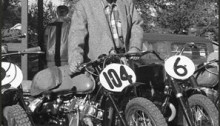A single-minded determination will motivate you to venture into new heights with renewed vigor. Soichiro Honda, founder of the Honda Motor Company, is known to be a man who defied clichés where Japanese businessmen are stringent. An

outsider to Japan’s industrial establishment, he became one of the 20th century’s industrial giants. This Japanese engineer and industrialist went from countless failures, innumerable adversities and threatening bankruptcies for over four decades in search of success. His persistent efforts, dedication and confidence finally paid off when he founded one of the largest automobile companies in the world. He was the first Japanese citizen to be inducted into Detroit’s Automotive Hall of Fame. To this day, Soichiro holds more than 100 patents.
Soichiro Honda was born in a small farming village. The eldest son of a blacksmith who repaired bicycles, he spent his early childhood helping his father in the repair business. At age 15, he dropped out of school to travel to Tokyo and look for work. There, he spent six years as a simple apprentice in an auto-repair shop where he quickly acquired a taste for fast cars. At the age of 21, he opened his own automotive shop. In 1923, however, the Great Kanto Earthquake destroyed Tokyo. It was during this calamity that Honda discovered his passion for motorcycles and the value of entrepreneurship.
In 1928, Honda returned to his home region and opened a garage of his own. His business prospered to the point of

having 50 employees in several shops. Before long, his company’s motorcycles and cars started to win numerous races, including national and world titles. During his spare time, he built his own racing car using an old aircraft engine and handmade parts. He even used the car when he entered the 1936 All Japan Speed Rally. But as he was approaching the finish line, he had a near-fatal crash, which cut short his racing aspirations. This accident could’ve stopped him from realizing his dream but instead it fueled his desire to pursue his greatest ambition. While recuperating from his injuries, Honda made a decision to get out of the garage business and expand into manufacturing.
He was never one to remain on the sidelines, and although he wasn’t very good at making piston rings, he persisted. He was painfully aware that he lacked basic knowledge of metallurgy, yet this did not discourage him. At the age of 31, he went back to school to learn about metals. He then applied the theories he learned inside the classroom later on.
After studying engineering, Honda began to invent and innovate. One of his early patents was a cast piston ring, which took him three long years of trial and error. Before perfecting the manufacture of a piston ring, he again faced another hurdle about quality control. When Toyota placed an order for 50,000 piston rings, only three out of 50 piston rings met the specifications during a random inspection. In 1945, he sold his company to Toyota to take a year’s sabbatical.
After the Second World War, Japan’s roads and railways were destroyed. Food shipments were not reaching cities while city dwellers had to walk or bike into the countryside to find food. Automobiles became a major part of postwar business recovery of Japan. Honda saw this business prospect and so he designed his own small engine out of small army engines left by the war. By 1948, the first product of Honda motor was made.
“Looking back on my work, I feel that I have made nothing but mistakes, a series of failures, a series of regrets,” a humble Honda said after he reached the finish line of his career. “But I am also proud of an accomplishment: Although I made one mistake after another, I never made the same mistake, and I always tried my hardest and succeeded in improving my efforts.”
He elaborated on that principle when he delivered a graduation speech to the class of ‘74 at Michigan Technological University. “Many people dream of success,” he said. “To me, success can only be achieved through repeated failure and introspection. In fact, success represents 1% of your work which results from the 99% that is called failure.”
Until Soichiro Honda’s death in 1992, the company continues to thrive as the most popular motorcycle manufacturer in the world and remains high in rankings of the world’s leading automobile manufacturers.
Soichiro Honda is the Honda Motor Company and everything he upholds—an untiring quest towards excellence in technology, a deep skepticism towards the status quo, an exceptionally democratic approach to business, and a strong interest with all things new and exciting. These qualities make Honda such a vital and important manufacturer of motorcycles. More than simply founding a successful corporation, Honda’s lasting impact to human history is his greatest achievement.
Honda is a man who turned adversities into success. For him, learning from failure is part of success. Honda held on to his belief that true success lies in one’s willpower to overcome hurdles and take risks. He lived by this principle by exemplifying that failure is where we learn most because failure creates and nurtures innovation. He proved that part of learning what works is also learning what doesn’t. Like Honda, we should count every failure as an essential stepping stone to the pinnacle of ultimate success and adversity as an opportunity to take us to a higher ground.
Sources:
https://www.asme.org/engineering-topics/articles/automotive/soichiro-honda
http://www.hemmings.com/hsx/stories/2007/05/01/hmn_feature19.html
http://honda.com.mt/about-us/the-history-of-the-honda-motor-company/
http://www.achieverscentre.com/achievers-motivational-stories-issue-3-story-3.php

